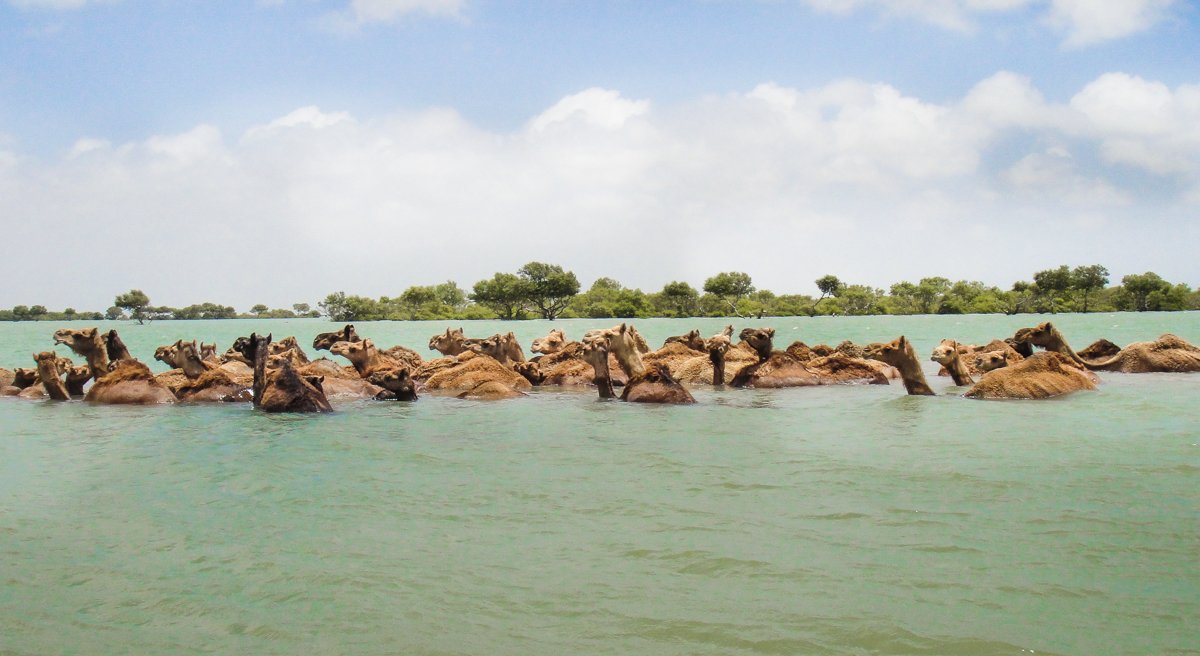
Introduction
India, a land of diverse cultures and traditions, is home to some truly unique and fascinating phenomena. One such marvel is the swimming camels of Gujarat, a captivating blend of nature and human ingenuity. These remarkable creatures have adapted to a lifestyle that allows them to thrive in the harsh coastal environment of the Arabian Sea. In this brief article, we will explore the extraordinary world of these swimming camels and the centuries-old tradition associated with them.
As we dive deeper into this narrative, we’ll uncover the historical significance of the swimming camels and their indispensable role in the region. From helping fishermen carry their daily catch from remote islands to the mainland to being a symbol of resilience and adaptation in the face of environmental challenges, these camels have been an integral part of Gujarat’s coastal life for centuries.

The Breed
The swimming camels, locally known as “Kharai,” belong to a distinct breed that has evolved over generations to survive in the coastal regions of Gujarat. Unlike their desert-dwelling counterparts, Kharai camels have developed webbed feet and can swim effortlessly through the saline waters of the Arabian Sea. This unique adaptation allows them to access islands and coastal areas where freshwater and vegetation are scarce.
Historical Significance
The history of swimming camels dates back centuries, and their role in the coastal communities of Gujarat is deeply rooted in tradition. These camels were initially used for transportation, helping fishermen carry their catch from remote islands to the mainland. Their swimming abilities made them indispensable for this task, as boats were not always a practical option in these shallow waters.
Beyond their practical uses, swimming camels became an integral part of the culture and traditions of Gujarat. They were featured in local festivals, folklore, and songs. The camels often appeared in traditional art forms, reflecting their importance in the collective imagination of the region.

Maldharis and Their Bond with Camels
The Maldharis are a semi-nomadic pastoralist group that has traditionally lived in the western Indian state of Gujarat and the surrounding regions. They have a deep connection with the Kharai camels and play a pivotal role in their care and well-being.
The Maldhari community has a long and rich history of camel rearing. For generations, they have been the custodians of these unique camels, raising them in the challenging coastal ecosystems of Gujarat. Their historical ties with the camels are deeply intertwined with the region’s culture and traditions. Maldharis are renowned for their expertise in camel husbandry. They possess intricate knowledge of the camels’ behavior, dietary requirements, and health. This accumulated wisdom has been passed down through oral traditions from one generation to the next.
For the Maldhari community and other coastal inhabitants, the tradition of camel rearing and camel-based livelihoods has been passed down through generations. These camels were not only used for transportation but also as a source of milk, meat, and hides. The camels’ role in daily life was deeply ingrained in the culture and identity of these communities.

Conservation Efforts
The Kharai camel population faced a decline in recent decades due to various factors, including habitat loss and a dwindling traditional way of life. However, concerted efforts by conservationists, local communities, and the government have helped protect and promote these remarkable creatures. Initiatives include breeding programs, ecotourism, and awareness campaigns aimed at preserving both the camels and their fragile coastal habitats.
National and state governments have recognized the importance of preserving the Kharai camels and their habitats. Legal protections, such as designating specific areas as wildlife sanctuaries or protected zones, help safeguard the camels from habitat destruction and poaching.
.jpg)
Modern Uses
In contemporary times, the role of swimming camels has evolved beyond transportation. Tourists are drawn to witness these unique creatures in action, and camel safaris along the coastline have become a popular attraction. Additionally, swimming camels have gained recognition for their resilience and adaptability in the face of environmental challenges, making them a symbol of local conservation efforts.
Swimming camels play a significant role in various cultural festivals and events in Gujarat. They are often featured in parades, fairs, and exhibitions, showcasing their unique swimming abilities to a wider audience. These events celebrate the rich cultural heritage of Gujarat and emphasize the importance of preserving the traditions associated with these camels.

Conclusion
The swimming camels of India are a testament to the remarkable ways in which humans and animals can coexist and adapt to challenging environments. This unique breed not only serves as a symbol of cultural heritage but also highlights the importance of conservation efforts in safeguarding the fragile ecosystems they inhabit. As we continue to celebrate the rich tapestry of traditions that India offers, the swimming camels remain a shining example of nature’s incredible resilience and the human spirit’s ability to find harmony with it.


